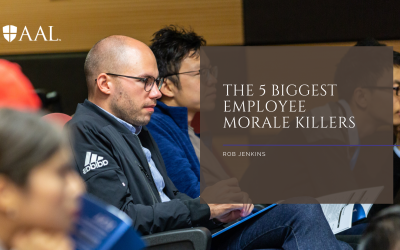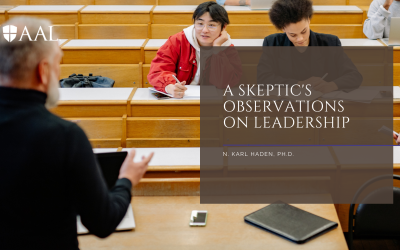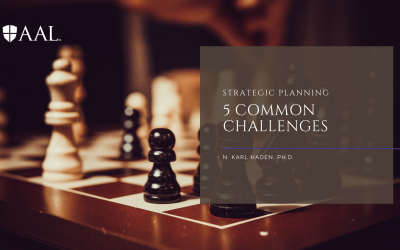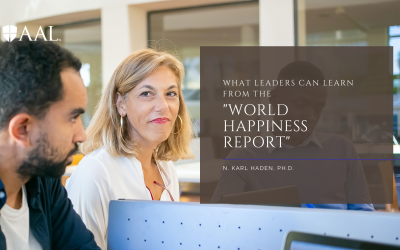Academic Leadership
Subscribe to NewsletterLatest News
ADA scholarships available for AAL’s Institute for Teaching and Learning
Three full-tuition scholarships are being granted by the ADA Council on Dental Education and Licensure to the Academy for Advancing Leadership’s Institute for Teaching and Learning as part of the Association’s commitment to supporting general dentist members who are interested in working in dental academia. The Institute for Teaching and Learning’s four-day program involves projects, group exercises, feedback and presentations and takes place Aug. 26-29 at ADA Headquarters in Chicago.
The International College of Dentists awarded AAL Founder and President Dr. Karl Haden the Leadership Article Award
The International College of Dentists awarded AAL Founder and President Dr. Karl Haden the Leadership Article Award for his article “The Character of a Profession: The Next 100 Years,” published in 2021 in the Journal of the American College of Dentists. The award ceremony was held on October 13, 2022, at the Annual Meeting of the American Association of Dental Editors and Journalists in Houston, Texas.
The 5 Biggest Employee Morale Killers
For nearly two-thirds of my 30-plus-year career, I have worked as a “middle manager” of one sort or another. For the remaining third—more than 10 years—I have been middle-managed.
Of course, even as a manager, I had plenty of people above me telling me what to do. I also had people below me who, given the chance, would gladly tell me what to do.
The point is that I know what it’s like to be on both sides of that transaction. Specifically, I understand first-hand what managers can do to make employees’ lives easier—and what they all-too-often do that makes employees’ lives more difficult (dare I say “miserable”?). Accordingly, I’d like to identify, for the benefit of new managers especially, what I consider the five biggest morale killers for employees, particularly in organizations that rely heavily on intellectual capital.
Micro-management. No one likes to have someone looking over their shoulder and telling them what to do all the time, especially intelligent, highly trained professionals. Many of today’s knowledge workers operate so autonomously, due to the nature of their work, that they can easily come to see themselves as independent contractors rather than employees.
From a management perspective, that’s not always a good thing. And yet some employees do require a certain amount of intellectual independence if they’re to do their best work. Clearly, managers are often required to maintain a very delicate balance between supervision and autonomy. Generally speaking, it’s better to err on the side of the latter.
Trust issues. Intelligent employees tend to interpret micro-management as lack of trust. Their leaders, they assume, simply don’t have enough faith in their ability or commitment to allow them to do their work as they see fit. Few things are more insulting to good employees, most of whom are deeply committed to their work and who in many cases know far more about it than their managers.
Of course, trust is a two-way street. To be happy and productive, employees need to feel that their managers trust them, but they also need to believe they can trust their managers—to be open and honest, to follow through on promises, and to have the best interests at heart.
In my experience, an organization suffering from low morale is almost always one where employees do not have that kind of confidence in their leaders—where trust has been broken.
Hogging the spotlight. When an organization succeeds, that is rarely attributable to any single individual. And yet it’s natural for leaders to want to take much of the credit, for several reasons: they’re the ones in charge, after all, so the success must be due to their great leadership; they need such documented successes to solidify their positions, not to mention pave the way for future promotions; and they often take a disproportionate share of the blame when things go wrong, so why shouldn’t they take most of the credit when things go right?
Such thinking may be natural, but it is anathema to a smooth-running organization. Leaders must embrace a number of behaviors that don’t necessarily come naturally, and one of those is deflecting praise. Effective leaders know that when their organization succeeds, they have succeeded, and they are content to spread the credit around while taking little or none for themselves. (Think about Tom Brady at the post-game press conference following a big Patriots win.)
Ineffective leaders sabotage morale and create a toxic environment by taking most of the credit for themselves, whether they deserve any of it or not.
The blame game. In addition to deflecting praise when things go right, leaders must also learn to accept the lion’s share of the blame when things go wrong.
That can be very difficult, especially if the failure really wasn’t their fault. Effective leaders understand, however, that just as they succeed when the organization succeeds, they also fail when the organization fails—whether or not the actual failure was their own. So they square their shoulders, accept the blame and accompanying criticism, and resolve to do better in the future.
(Note that “doing better” may well involve some very intense conversations with the people who were actually to blame. But those conversations should be kept, as much as possible, behind closed doors.)
Weak and ineffectual leaders, on the other hand, are always looking for someone else to blame. Nothing is ever their fault, even when it clearly is. I can’t think of a better recipe for destroying morale in any organization.
Blatant careerism. Finally, we come to one of my own personal pet peeves: leaders whose sole ambition in life is to climb as high as possible on the executive ladder and who are willing to do literally anything to achieve that ambition.
Okay, maybe not “anything.” I’ve never known a manager who committed murder in order to get a promotion, although I’ve known a few who probably thought about it. But “anything,” in this case, can definitely include throwing the people they lead “under the bus,” as the rather graphic colloquialism puts it—pointing the finger at others when things go wrong in order to inoculate themselves against blame and ratting people out for minor infractions in order to ingratiate themselves with the powers-that-be.
“Anything” can also include using the people under them as stepping stones for their own ambitions—taking credit for their achievements and/or giving them make-work assignments that do little more than enhance the leader’s own resume.
I once worked for someone exactly like that. I used to duck into the men’s room anytime I heard the distinctive clip-clop of her high heels coming down the hallway, because I knew any “casual” meeting would result in a new project for me, the only purpose of which was to make her look better in the eyes of her superiors.
That’s no way to build morale. In fact, that’s exactly how you kill it, along with micro-managing, breaking trust, hogging credit, and deflecting blame. Leaders who behave that way, in my experience, might enjoy some apparent success in the short term but will rarely succeed over the long term, partly because they don’t usually last that long.
Of course, that’s not the only reason managers should try to build morale rather than destroy it. Effective leaders try to create a workplace where people are comfortable and fulfilled, where they feel valued and believe what they’re doing has meaning. People in that situation are likely to be more productive, making the organization a success and creating plenty of credit to go around—even for a leader determined to deflect as much of it as possible.
Author:

Rob Jenkins
Professor, AAL Senior Fellow, co-author of The 9 Virtues of Exceptional Leaders
A Skeptic’s Observations on Leadership
Having just finished another article on leadership, I’m reminded of why I find most modern treatments of the subject uninspiring, uninformed, repetitive, and unoriginal. No matter what color the wrapping, inside the best books and articles on leadership is a similar nougat. While the emergence of social sciences in the early 20th century led to prolific studies of leadership, some of the most enlightened and enlightening thinking about leadership occurred 2000 years ago, give or take a few centuries. Literally thousands of books are published each year about leadership. The repackaged ideas that pass for novel thinking on the subject have existed for a long time, articulated best when they were articulated first.
Steven Covey’s The 7 Habits of Highly Effective People has sold over 15 million copies since its publication in 1989. The popularity of The 7 Habits attests to its ability to engage and interest the reader and to its applicability. However, the importance of good habits in human well-being was examined profoundly much earlier than the late 20th century, most especially by Aristotle in the 4th century BC. The discerning student of leadership will find in Book One of Marcus Aurelius’s Meditations notions that have become modern theoretical constructs known as transformational leadership, transactional leadership, adaptive leadership, servant leadership, exemplary leadership, heroic leadership, level-5 leadership, primal leadership, and the like. When I buy or am given any new text on leadership, I admit that I read it through jaded eyes. I’m a skeptic that modern leadership theory will have anything new to offer. Sometimes I’m surprised and I do see something in a new light. I’m hopeful for more surprises.
To admit skepticism about modern leadership theory might seem contradictory or at least paradoxical, coming from someone who has recently co-authored my own book on the subject, The 9 Virtues of Exceptional Leaders. I don’t mean to suggest that the study and practice of leadership is unimportant. On the contrary, leadership is more important now than in any time in human history because so much is at stake with our planet, in our societies, communities, and organizations and for each of us individually in this time of challenge, change, and opportunity. What I hope to elucidate is my contention that most contemporary treatments of the topic are shadows of ancient wisdom regarding the timeless heart of leadership: ethos or character, which Rob Jenkins and I describe in our new book as virtue.
It’s fair to say that the ancients weren’t preoccupied with theories of leadership. However, they were much taken with the subject of human excellence and well-being. The term for excellence is arête, which is often translated as “virtue” and relates to functional excellence. For example, the functional excellence, or virtue, of the eye is to see well. The virtue of the physician is practice to ensure a healthy patient.
What then is the functional excellence of a human being? It is to live well, and not simply from the standpoint of material possessions. Living well requires that we engage in those things that are the highest expressions of our humanity: learning and growing intellectually and emotionally, belonging and contributing to the experience of family and friendships, and engaging as a citizen of the human community, from our neighborhoods, to the places in which we work, to the global community. Virtue is very much a practical concept, guiding how one lives his or her life. Yet it goes beyond the ethical consideration of how one ought to live to a deeper self-examination: What ought one to be? The ancients referred to this concept as ethos.
What is the virtue of leadership? To lead well. But what does leading well mean? There is no doubt that leadership requires technical expertise. For example, most of what happens in business schools to educate managers and leaders is about developing technical expertise. Effective leadership requires something else—it requires ethos. Ethos is the very heart of leadership. It raises the question about the type of person one wishes to become as a leader and the type of person that we want as our leaders.
For example, honesty or trustworthiness seems to be a sine qua non of leadership. Add to that other personal virtues such as humility, courage, perseverance, and justice—virtues that are well described by the ancients and which Rob and I discuss at great length in our book. The point is not merely that the leader knows a lot about humility, courage, and the like, but that he or she embodies these habits of excellence—and they are indeed habits—through practicing of them regularly.
This ancient way of thinking about leadership accentuates the importance of role modeling, mentoring, leading by example, and growing in self-knowledge through study and reflection. It minimizes the perception of leadership as a set of techniques, the reification of formulaic behaviors. Hence, would-be leaders at all levels must ask two questions, in this order: “What kind of person do I aim to become?” and “What kind of leader do I want to be?” Considerations of skills and the techniques of managing follow.
Virtue is thus a necessary condition for leadership, as Rob and I have attempted to make clear in The 9 Virtues. To the extent that we understand and adhere to this concept, I believe we are tapping into ancient wisdom that can help us become better leaders in these modern times.
Does that mean we should require emerging leaders to read Aristotle, Marcus Aurelius, and others from the pantheon of intellectual antiquity? Why not? But at the very least, they should be able to get a good taste of these ideas by reading The 9 Virtues.
Author:
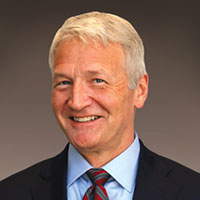
N. Karl Haden, Ph.D.
President of AAL & co-author of The 9 Virtues of Exceptional Leaders and 31 Days with the Virtues
Making Tough Career Choices: 5 Questions to Ask Yourself
Two roads diverged in a yellow wood,
And sorry I could not travel both…
Robert Frost
Last year, during one of our large leadership programs, a participant asked me about a major career choice she faced. In this case, the choice involved leaving her organization and taking a different career path. Many of life’s dilemmas, including tough career choices, become dilemmas precisely because evidence and reason fail to provide clear direction. In situations where there is no clear direction, it is important to see the matter from various perspectives.
But how does one see in a new and different light? While not a protocol for tough career choices, or more broadly, life’s dilemmas, I have found the following questions and corresponding actions, taken as a whole, to be helpful.
What do my mentors and friends think? Most people have a handful of people who know them well, have varied life experiences, and who possess recognizable wisdom about life. Whether these individuals are mentors, a spouse or significant other, other close friends, or all of the above, they are a ready resource to help one reframe career choices. Whenever I’m stuck, I talk with mentors and friends. The advice usually helps—sometimes I take it, other times not, but talking about the dilemma helps me think and feel through it.
What are my motivations? Or, phrased somewhat differently, what’s important to me? Tough career choices present opportunities to examine and re-examine what brings satisfaction and happiness; they touch virtually every other aspect of our lives. Consequently, they should be examined in the light of a person’s total life commitments.
Dilemmas often come in the form of having two or more good choices. While not always the case, I have found that looking at career choices in the broader context of what’s important in life elucidates the situation. Why would I want to do this? How does this direction fit with my family, my social life, my mental, spiritual, and physical well-being?
How does the matter look on paper? I’m not referring to the numbers. Rather, this question reflects a simple technique that I personally find helpful. I do my best thinking with a pencil and paper. Whether it’s a pro/con list or just trying to map out a direction and options, putting my thoughts on paper seems to help.
How does the matter look to the uncluttered mind? This question is about meditation. While meditation can mean many things, in this case I’m referring to clearing the mind of the usual clutter. If one pauses for 10 seconds, he or she will hear and observe a myriad of ideas, conversations, hopes, and fears firing across the brain. Trying to hush the noise to give one’s mind a respite is difficult but vital to seeing things differently and more clearly. I sometimes sit quietly; sometimes exercise. Sometimes there is music; other times, not. Sometimes the meditation takes the form of emptying the mind and sometimes it’s meditation on personal mission or values. However one seeks to unclutter the mind, carving out protected time to clean house is essential.
Can I live with the choice? In some ways, choice is more fundamental than reason. As noted above, choices become dilemmas when the evidence and reason fail to identify clearly the path we ought to take. I’ve made a few really bad choices, and paid the price, but in most cases it works out. In the end, I act. It may be a reasonable decision, but the big choices are almost always a step of faith believing that it’s going to work out.
Ultimately, living with one’s choices requires self-confidence. Even if a person unwittingly makes a bad choice, they must enter the situation convinced that they can either make it work or work their way out of it. Having self-confidence to figure out things along the way is a mark of personal leadership.
Author:

N. Karl Haden, Ph.D.
President of AAL & co-author of The 9 Virtues of Exceptional Leaders and 31 Days with the Virtues
Why “Soft” Skills Aren’t Really Soft
Today, emerging leaders will likely have a college degree, technical qualifications (making them theoretically competent to perform the tasks required of them), and relevant work experience—but what about the personal attributes that enable leaders to interact effectively and harmoniously with others, or what we sometimes refer to as “soft skills”?
The word “soft,” in this context, introduces a spectrum of connotations. Where skills or competencies are concerned, it is juxtaposed to “hard.” The implication is that hard skills are somehow substantial, while soft skills are somewhat ethereal. Some might believe that acquiring soft skills is less demanding than the rigor necessary to develop hard skills, basing this assumption on popular notions of the sciences—empirical, measurable, practical—as opposed to the humanities—intuitive, indefinite, and valued as intrinsically good rather than instrumentally so.
Rather than calling them “soft skills,” and perhaps thereby implying they are less important, I propose that we think of them simply as essential leadership skills. In actuality, it is the technical or “hard skills” that are non-essential. In leadership, one can easily find people who can do the technical things, but communication, motivation, social adeptness, vision—indispensable skills for leaders—are harder to come by. Hard skills are less important as one assumes more responsibility as a leader; but so-called “soft skills” are the sine qua non for effective leadership. They are truly essential.
Today’s emerging leaders must display innovative, cultural, interpersonal, and intrapersonal skills in the broadest possible sense. Interpersonal and relationship-building skills help people communicate and collaborate effectively. Unfortunately, such skills are often overlooked and undervalued by today’s students, faculty, and administrators.
What are these leadership skills and why are they so critical? These essential skills include:
Effective communication
Acting as a team player
Networking
Problem solving and critical thinking
Professionalism
Accepting feedback and applying lessons learned
Working collaboratively
Managing time
Personal confidence
Social integrity
These are skills that will help anyone in a wide range of jobs, not just a current or target position.
It’s true that, to get and keep a job, one must be competent in certain technical skills. However, given the same technical skills and level of competence, what is the primary reason one person is chosen over another for promotion and advancement? While technical skills and competency might get one’s foot in the door, essential leadership skills push that door open wide. One mistake that should not be overlooked is the assumption these essential skills are easily mastered. The sad fact is that many people never become competent in these interpersonal abilities and never fulfill their potential.
Today’s work environment has evolved to the point where the interpersonal dynamic no longer can be ignored. The acts of listening, presenting ideas, resolving conflict, and fostering an open and honest culture all come down to knowing how to build and maintain relationships with people. It’s those relationships that allow people to participate fully in team projects, show appreciation for others, and enlist support for their projects—that, ultimately, make them effective team members and effective leaders.
Author:
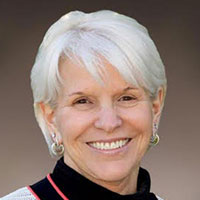
Marcia M. Ditmyer, PhD, MS, MBA, MCHES
AAL Senior Consultant
Strategic Planning: 5 Common Challenges
Strategic planning is a process, an outcome, and—in its best form—a roadmap used by stakeholders throughout an organization to move the organization toward higher levels of achievement. Strategic planning is also a much-maligned endeavor, subject to the usual (and frequent) criticisms: too much time, too much money, and too little action.
Having watched more strategic plans than I can count gather proverbial dust, I’d like to reflect for a moment on our experiences at AAL helping organizations create a strategic plan. There are many reasons such plans fail, but the following five challenges are among the most common:
Lack of leadership. If the leaders of the organization, program, or department do not support the plan, it will fail. This point seems obvious, but far too often leaders talk about the importance of the strategic plan as the planning process gets underway, only to show little interest down the line.
I’m thinking of a senior administrator who appeared exactly three times, for about 15 minutes each time, over a period of one year to express to his strategic planning task force how important their work was to the institution. At virtually every other gathering associated with the process, he sent an emissary to convey the importance of the strategic plan. Do you suppose those task force members viewed the process as extremely important?
How do leaders contribute to the success of the plan? They are present and engaged at the right times with the right people. Most important is their ongoing leadership responsibility: they think strategically. Strategic thinking is guided by vision, mission, and values. Strategic thinking and consequent action aligned with a clear vision of the future are an antidote to the inevitable environmental changes that undermine the details of strategic plans. Strategic thinking is ultimately about staying the course over time, in spite of detours caused by unforeseen circumstances.
Lack of consensus. I have heard more than once that the process of strategic planning is what matters, not the product. Of course, the process itself is vital; yet if an organization is serious about implementing the plan, then an excellent product is imperative.
Strategic planning is about consensus building. Done correctly, the process promotes communication, participation, and collaboration. It provides a structured forum for airing conflicts, dealing with the inevitable political struggles, and negotiating the purpose and meaning of an organization and one’s place in it. While a true consensus about all issues among all stakeholders is unrealistic, engaging everyone through interviews, focus groups, surveys, open forums, and the like is essential if leaders expect them to implement the plan.
Such engagement of others requires time. There are no formulas for the right amount of time. Too much and people lose interest or become mired in details; too little, and they feel unheard. Yet the results of this consensus-building process represent the antithesis of the plan developed by committee or the lone administrator behind closed doors.
Too ambitious. Who can predict what will happen when bright, highly motivated, visionary people are charged to participate in strategic planning? One likely outcome is that from fertile minds will grow a garden of luscious ideas. After all, germinating ideas is a core competency of most professionals.
Tending the garden, however, is an altogether different task. It involves additional human and financial resources, more time and effort, and the willingness to get one’s hands dirty by actually doing something with the idea. Overly ambitious plans tend to outstretch resources and become complicated in the implementation phase. They often have too many goals, including some that are simply unfeasible for the organization in a three-to-five-year window.
The problem of too many goals is exacerbated by implementation planning. I have seen strategies and goals deconstructed into literally hundreds of specific objectives. Even if an organization has full-time staff devoted to strategy and planning, such plans become unwieldy, demoralizing, and ultimately unhelpful as an actionable guide.
Failure to integrate the plan into the culture, operations, and budget. Failures often occur because the strategic plan is divorced from the daily life of an organization. Leaders must model the plan, and that includes talking about it—often. Every public venue and most closed venues are opportunities to stress the vision, mission, and values of the organization.
Integration involves implementing specific, measurable objectives at all levels. Tying decision-making and resource allocation to the plan is vital to making it a part of the institution’s daily life. From the departmental to the institutional level, all defining structures of the organization must be informed by the plan, including budgets, recruitment and development, curricula, and so forth. A fully integrated plan moves everything and everyone (well, most everyone—detractors and cynics reside in all organizations) in the same general direction.
Lack of momentum in the short term. The window of strategic plans continues to get smaller. When strategic planning first emerged as an organizational expectation, a plan spanning 10 years or more was not uncommon. Today, we typically advise our clients to consider a three-to-five-year window.
Even with a shorter time frame, an annual (or sometimes biennial, depending on the environment), systematic assessment of the plan is necessary for course corrections. The planning process itself should create momentum, but as noted above, if the process takes too long, then those involved begin to lose their enthusiasm. Thus the timeline is important; staying with an aggressive timeline sends the message that the planning is a serious endeavor.
Ideally, during the planning process itself, an organization will discover areas for growth and make important changes. To ensure that the strategic plan does not fall stillborn from the printer, institutions should act as quickly as possible. This means identifying those steps that can be taken in the short term and moving forward to implement them. Equally important is making sure that stakeholders know the institution has moved deliberately and decisively to act on the plan. Thus leaders must communicate their actions often and through a variety of media. Momentum in the short term conveys the message that the planning process was a serious undertaking and that the resulting strategic plan is a living document.
Strategic plans need not gather dust on a shelf. They can and should be living documents that guide an organization on a daily basis. In today’s rapidly changing and unpredictable environment, a practicable strategy is more important than ever. Organizations that meet the challenges above have much better outcomes from their strategic plan.
In the end, of the challenges listed above, the first is the greatest: the plan will succeed or fail on the strategic thinking and acting of its leaders.
Author:

N. Karl Haden, Ph.D.
President of AAL & co-author of The 9 Virtues of Exceptional Leaders and 31 Days with the Virtues
What Leaders Can Learn from the “World Happiness Report”
In Chapter 9 of The 9 Virtues of Exceptional Leaders, titled “Hope,” Rob and I devote several paragraphs to discussing the work of Viktor Frankl, a survivor of both Auschwitz and Dachau and the father of logotherapy—a theory founded on the belief that human nature is motivated by the search for purpose. Frankl once wrote, “Ever more people today have the means to live, but no meaning to live for.” Another way of stating Frankl’s point is that people need hope, the vision of a better future. Leaders bring hope to organizations, communities, and societies. Leaders help others make meaningful lives. The recent publication of the World Happiness Report reminded me that hope, meaning, wellbeing, and happiness are familial concepts. What can leaders learn from this report?
First, so much for “melancholy Danes.” For the third time since the publication of the first World Happiness Report in 2012, Denmark is ranked as the happiest country in the world. Switzerland, Iceland, and Norway followed, with the United States ranking 13th in overall happiness. The 2016 report is an update in anticipation of the World Happiness Report 2017. Led by the Sustainable Development Solutions Network, a global initiative of the United Nations, these studies aim to establish a scientific, empirically verifiable basis to measure humans’ subjective accounts of their well-being. Most of the differences in happiness among countries and regions result from six key variables: (1) GDP per capita; (2) healthy years of life expectancy; (3) social support (e.g., having someone to count on in times of trouble); (4) trust (as absence of corruption in government and business); (5) perceived freedom to make life decisions; and (6) generosity (e.g., donations to charity). According to the editors of the 2016 update, “increasingly, happiness is considered to be the proper measure of social progress and the goal of public policy.” A fundamental premise of these ongoing studies is that “subjective well-being provides a broader and more inclusive measure of the quality of life than does income.”
In a chapter entitled “Secular Ethics,” Richard Layard, director of the Well-Being Programme at the London School of Economics and Political Science’s Center for Economic Performance, describes three propositions that comprise the “greatest happiness principle”:
1. Human progress should be assessed by the extent to which individuals are enjoying their lives. Enjoyment is defined by the prevalence of happiness and the absence of misery.
2. The objective of governments should be to create the conditions for the greatest possible happiness and the least possible misery.
3. Likewise, every individual has an obligation to create the greatest amount of human happiness in the world and the least misery.
The greatest happiness principle calls for us to care not only about our own wellbeing, but also about the wellbeing of others. Layard states that human nature is both selfish and altruistic. Moreover, he argues that we need an ethical system to promote the altruist within us over the egotist. Historically, ethical codes of conduct have come from various sources, most especially religious traditions. Layard maintains that, “In an ever more secular society, we urgently need non-religious organisations which promote ethical living in a way that provides inspiration, uplift, joy and mutual support—through regular meetings of like-minded people.” Such organizations need not be anti-religious; they simply need to provide a structure that will allow for the actualization of the greatest happiness principle.
While there are numerous organizations that can provide such inspiration, uplift, joy, and mutual support, I would like to propose that the workplace provides the greatest opportunity to create these conditions. For the majority of employed people, the workplace is where they spend most of their waking time. In a sense, workplaces create their ethical codes of conduct. Workplaces have cultures, characterized by values (whether explicit or implicit), and policies. For most people, the type of work they do, those with whom they work, and the rewards of work (monetary and otherwise) are fundamental to their sense of wellbeing and happiness.
What can leaders learn from the World Happiness Report? Income matters to employees, but other factors are more important to fostering a sense of wellbeing. In his book Drive: The Surprising Truth about What Motivates Us, Daniel Pink uses decades of research to argue that the secret to high performance and satisfaction is the human need to direct our own lives, to learn and create new things, and to improve ourselves and our world. Pink and others found that monetary rewards work best when the task is simple and straightforward. However, once even rudimentary cognitive skills are involved, larger rewards actually led to poorer performance. Pink found that granting people autonomy and self-direction actually improves engagement with the task and others. He argues that for most people, mastery is also a motivation: we by nature want to get better at what we do. Lastly, people are motivated by purpose—they want to know that what they do matters. I call this type of work meaningful work; and it matters not only in terms of motivation, but also to one’s sense of wellbeing—one’s happiness.
A basic question for leaders is whether the culture of the departments, units, schools, and organizations they lead values autonomy, mastery, and purpose. Policies should foster self-direction. Vision, mission, and values must be discussed, debated, implemented, and lived. The leader’s attitudes and behavior should be consistent with espoused values of individual worth. The leader cannot possibly ensure that a given employee feels happy all of the time, or that the employee has all of his or her desires met. However, the leader does have a responsibility to create a meaningful workplace. If we return to Layard’s three propositions comprising the greatest happiness principle and apply them to our organizations, the leadership challenge might take the form of these questions:
1. What am I doing to ensure that people enjoy working here?
2. How do I create the conditions (culture, opportunities, etc.) where people can grow, thrive, and make meaningful contributions?
3. How can our organization maximize its purpose to make the community and the world a better place?
I would offer that happiness and wellbeing are not only “a proper measure of social progress and the goal of public policy,” but should also serve as a measure of the work environment and the societal goal of our schools and businesses.
Author:

N. Karl Haden, Ph.D.
President of AAL & co-author of The 9 Virtues of Exceptional Leaders and 31 Days with the Virtues



